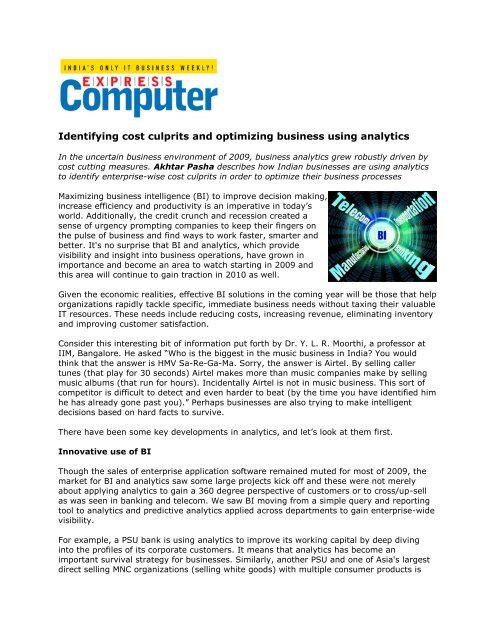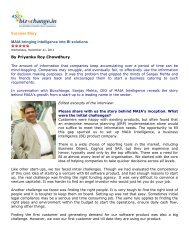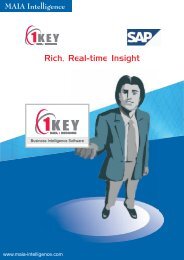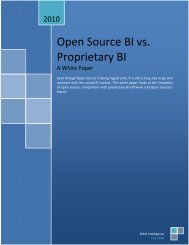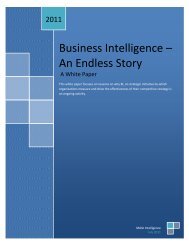Identifying cost culprits and optimizing business using analytics
Identifying cost culprits and optimizing business ... - MAIA Intelligence
Identifying cost culprits and optimizing business ... - MAIA Intelligence
Create successful ePaper yourself
Turn your PDF publications into a flip-book with our unique Google optimized e-Paper software.
<strong>Identifying</strong> <strong>cost</strong> <strong>culprits</strong> <strong>and</strong> <strong>optimizing</strong> <strong>business</strong> <strong>using</strong> <strong>analytics</strong><br />
In the uncertain <strong>business</strong> environment of 2009, <strong>business</strong> <strong>analytics</strong> grew robustly driven by<br />
<strong>cost</strong> cutting measures. Akhtar Pasha describes how Indian <strong>business</strong>es are <strong>using</strong> <strong>analytics</strong><br />
to identify enterprise-wise <strong>cost</strong> <strong>culprits</strong> in order to optimize their <strong>business</strong> processes<br />
Maximizing <strong>business</strong> intelligence (BI) to improve decision making,<br />
increase efficiency <strong>and</strong> productivity is an imperative in today’s<br />
world. Additionally, the credit crunch <strong>and</strong> recession created a<br />
sense of urgency prompting companies to keep their fingers on<br />
the pulse of <strong>business</strong> <strong>and</strong> find ways to work faster, smarter <strong>and</strong><br />
better. It's no surprise that BI <strong>and</strong> <strong>analytics</strong>, which provide<br />
visibility <strong>and</strong> insight into <strong>business</strong> operations, have grown in<br />
importance <strong>and</strong> become an area to watch starting in 2009 <strong>and</strong><br />
this area will continue to gain traction in 2010 as well.<br />
Given the economic realities, effective BI solutions in the coming year will be those that help<br />
organizations rapidly tackle specific, immediate <strong>business</strong> needs without taxing their valuable<br />
IT resources. These needs include reducing <strong>cost</strong>s, increasing revenue, eliminating inventory<br />
<strong>and</strong> improving customer satisfaction.<br />
Consider this interesting bit of information put forth by Dr. Y. L. R. Moorthi, a professor at<br />
IIM, Bangalore. He asked “Who is the biggest in the music <strong>business</strong> in India? You would<br />
think that the answer is HMV Sa-Re-Ga-Ma. Sorry, the answer is Airtel. By selling caller<br />
tunes (that play for 30 seconds) Airtel makes more than music companies make by selling<br />
music albums (that run for hours). Incidentally Airtel is not in music <strong>business</strong>. This sort of<br />
competitor is difficult to detect <strong>and</strong> even harder to beat (by the time you have identified him<br />
he has already gone past you).” Perhaps <strong>business</strong>es are also trying to make intelligent<br />
decisions based on hard facts to survive.<br />
There have been some key developments in <strong>analytics</strong>, <strong>and</strong> let’s look at them first.<br />
Innovative use of BI<br />
Though the sales of enterprise application software remained muted for most of 2009, the<br />
market for BI <strong>and</strong> <strong>analytics</strong> saw some large projects kick off <strong>and</strong> these were not merely<br />
about applying <strong>analytics</strong> to gain a 360 degree perspective of customers or to cross/up-sell<br />
as was seen in banking <strong>and</strong> telecom. We saw BI moving from a simple query <strong>and</strong> reporting<br />
tool to <strong>analytics</strong> <strong>and</strong> predictive <strong>analytics</strong> applied across departments to gain enterprise-wide<br />
visibility.<br />
For example, a PSU bank is <strong>using</strong> <strong>analytics</strong> to improve its working capital by deep diving<br />
into the profiles of its corporate customers. It means that <strong>analytics</strong> has become an<br />
important survival strategy for <strong>business</strong>es. Similarly, another PSU <strong>and</strong> one of Asia's largest<br />
direct selling MNC organizations (selling white goods) with multiple consumer products is
trying to achieve data harmony by cleaning its customer data (addresses) existing in<br />
multiple systems <strong>and</strong> reported in multiple formats. A FMCG company is <strong>using</strong> <strong>analytics</strong> to<br />
check the incentives passed on to retailers for <strong>using</strong> their shelf space. Manufacturing<br />
companies are <strong>using</strong> it to reduce their production wastage <strong>and</strong> optimize spend management<br />
as well as spare parts availability.<br />
The bulk of the traction was seen in government projects, BFSI for risk analysis <strong>and</strong><br />
management of churn, compliance, non-discretionary spend, customer intelligence <strong>and</strong> to<br />
identify best customers, customer retention, warranty analysis <strong>and</strong> <strong>optimizing</strong> <strong>and</strong> cutting<br />
<strong>cost</strong>s in the supply chain.<br />
Sanjay Mehta, CEO, MAIA Intelligence, said, “In 2009, we saw most predictions going awry.<br />
However, <strong>analytics</strong> was used as a means of cutting <strong>cost</strong>s by many <strong>business</strong>es. Customers<br />
are not ready to wait for a long term deployment as they face rapid growth in data volumes,<br />
M&A, government regulations <strong>and</strong> competition. So instead of the traditional approach to BI<br />
that involved building a data warehouse, customers have started directly <strong>using</strong> the<br />
predictive <strong>analytics</strong> model.”<br />
Having said that, let us investigate this trend <strong>and</strong> its impact on <strong>business</strong>es across key<br />
verticals such as government, BFSI, telecom, software houses, FMCG, brokerage houses<br />
<strong>and</strong> how they are <strong>using</strong> it end-to-end to manage their growth, optimize, reduce <strong>cost</strong>s <strong>and</strong><br />
improve their top line revenues.<br />
We've seen a growing dependence on BI <strong>and</strong> <strong>analytics</strong> across industries to drive better,<br />
faster decision-making <strong>and</strong> reduce risks. Customers are telling us that BI is no longer a<br />
nice-to-have, but a must-have to survive <strong>and</strong> thrive in today's increasingly competitive<br />
market.<br />
Query <strong>and</strong> reporting moves to <strong>business</strong> <strong>analytics</strong><br />
"Analytics was used<br />
as means of cutting<br />
<strong>cost</strong>s by many<br />
<strong>business</strong>es. Instead of<br />
the traditional<br />
approach to BI that<br />
involved building a<br />
data warehouse,<br />
customers started directly <strong>using</strong> the<br />
predictive<br />
<strong>analytics</strong> model"<br />
- Sanjay Mehta<br />
CEO, MAIA Intelligence<br />
For more than 40 years, IT focused on operational efficiency.<br />
Companies used to use IT to automate front <strong>and</strong> back office<br />
operational systems that resulted in tremendous gains in<br />
operational productivity, but the same technology consistently<br />
failed to meet the needs of decision-makers. Business users<br />
were frustrated because although they understood the<br />
<strong>business</strong> <strong>and</strong> the data, they still had to spend so much of their<br />
time finding it, massaging it, <strong>and</strong> having to do it all over again<br />
when they needed to run a report with fresh data.<br />
BI has moved on from query <strong>and</strong> reporting tools, though<br />
st<strong>and</strong>ardized <strong>and</strong> efficient reporting remains the best way to start any BI project. Areas that<br />
are getting a boost from BI initiatives include customer, risk <strong>and</strong> product management.<br />
CIOs these days are talking about how their core <strong>business</strong> can get the agility needed to act<br />
profitably in as real time a manner as possible <strong>and</strong> they are looking at all areas within the<br />
enterprise for leveraging the same. Organizations need fast, flexible reporting systems that<br />
allow them to quickly access <strong>and</strong> analyze data.<br />
Today, analytical excellence is the name of the game. Winners <strong>and</strong> losers are determined by<br />
the quality of predictions <strong>and</strong> decisions <strong>and</strong> immediate access to information across the<br />
enterprise is m<strong>and</strong>atory. BI is an enabler for competitiveness.<br />
Let us now closely examine how <strong>business</strong>es are leveraging <strong>analytics</strong> end-to-end.
Identify <strong>cost</strong> <strong>culprits</strong><br />
Mehta cited the example of Reliance Mutual Fund which is <strong>using</strong> 1KEY <strong>analytics</strong> end-to-end<br />
to manage its <strong>business</strong>. The company uses 1KEY intelligence that pulls the data from nine<br />
mission critical applications used by fund managers, risk team, treasury, research, sales <strong>and</strong><br />
marketing, MIS, operations <strong>and</strong> IT.<br />
To boost revenue growth<br />
Manufacturing customers would require spend <strong>analytics</strong> extending enterprise performance<br />
management (EPM) into <strong>business</strong> operations, giving <strong>business</strong> users organization-wide the<br />
ability to pinpoint potential opportunities for <strong>cost</strong> savings, rationalize suppliers in tune with<br />
corporate strategy <strong>and</strong> track compliance with vendor contracts.<br />
For example, Bharat Forge Limited (BFL), the world’s largest forging conglomerate, is <strong>using</strong><br />
the 1KEY Agile BI Suite to meet reporting <strong>and</strong> <strong>analytics</strong> challenges associated with its<br />
greatly accelerated <strong>business</strong> growth. The software is able to generate complex reports as<br />
per the company’s needs. BFL is collecting a massive amount of manufacturing, customer,<br />
<strong>and</strong> <strong>business</strong> data through a variety of channels. As a part of the project, the MAIA team<br />
<strong>and</strong> its partners will connect to the SAP system <strong>and</strong> generates reports like Variance<br />
Analysis, Cost Reduction reports, Exports Tracking report, Actual Consumption vs. Budget<br />
report, Daily Production report <strong>and</strong> so on. To start with, data from the manufacturing,<br />
finance <strong>and</strong> operations will be connected to 1KEY’s visual information dashboards <strong>and</strong><br />
content-rich reports for insights into inventory, <strong>cost</strong>s, customers, profitability <strong>and</strong> key<br />
<strong>business</strong> areas including revenue management, reservations, management reporting <strong>and</strong><br />
performance analysis. BFL will also use 1KEY for market performance analysis, operations,<br />
strategic account management, <strong>and</strong> global sales analysis on a daily basis.<br />
Reducing IT <strong>cost</strong>s; tracking operations <strong>and</strong> SLAs<br />
The IT team at Reliance Mutual Fund uses 1KEY to track <strong>and</strong> manage all the SLAs for its<br />
nine applications <strong>and</strong> vendors. It has given the company sufficient proof points on<br />
application downtime vis-à-vis agreed ratio, as the fund’s <strong>business</strong> directly depends on<br />
applications <strong>and</strong> IT systems. Similarly, the company has created metrics <strong>and</strong> SLAs that used<br />
1KEY to manage the AMC of hardware systems.<br />
Analytics in energy forecasting<br />
India Inc. has taken a giant leap into <strong>business</strong> <strong>analytics</strong>. The story is quite absorbing as it<br />
captures how <strong>business</strong>es have started applying <strong>analytics</strong> end-to-end in <strong>optimizing</strong> their<br />
<strong>business</strong> functions <strong>and</strong> cut <strong>cost</strong>s to safeguard their margins, profits, meet customer<br />
expectations <strong>and</strong> reduce risk. We expect the trend <strong>and</strong> momentum to continue in 2010.<br />
akhtar.pasha@expressindia.com<br />
http://www.expresscomputeronline.com/20100315/trend01.shtml


